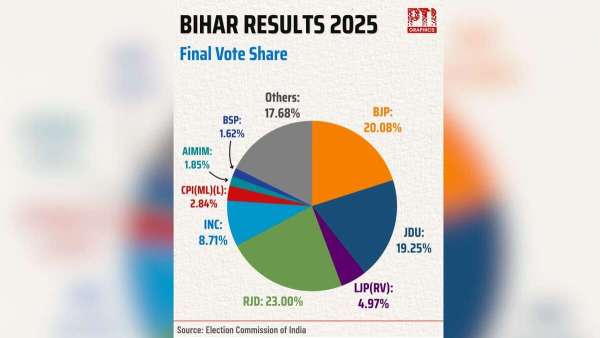
The 2025 Bihar elections were a litmus test for the National Democratic Alliance (NDA) and Mahagathbandhan. And the former sweeped an overwhelming 202 seats while the latter barely scraped 35, a stark contrast to the neck-and-neck battle of 2020, when both alliances had nearly identical vote shares – 37.3 percent vs 37.2 percent – respectively.
On Friday, the ruling NDA cemented its place in the 243-member Assembly by bagging two-thirds majority, with many winners emerging from the Bharatiya Janata Party (BJP). Nitish Kumar’s Janata Dal (United) won 83 seats while Chirag Paswan’s party Lok Janshakti Party (Ram Vilas) won 19 seats.
In the Mahagathbandhan camp, Tejashwi Yadav’s Rashtriya Janata Dal (RJD) won 25 seats and Congress got only 6.

BJP’s vote share increases, RJD’s worst nightmare comes true
The BJP marginally increased its vote share, from 19.5 percent in 2020 to 20.4 percent this time, while the JD(U) made an impressive comeback, jumping from 15.4 percent to 19.6 percent.
The RJD grew from a mere 23.1 percent to 23.4 percent, suffered its worst strike rates. The Congress, well, it slid further down.
AIMIM, Jan Suraaj and Dalit votes
So where did it go wrong? The real shift came from three smaller players: Prashant Kishor’s Jan Suraaj, Asaduddin Owaisi’s AIMIM and Mayawati’s Bahujan Samajwadi Party (BSP).
Lets break it down.
Jan Suraaj, which contested in its first ever Assembly election got 3.4 percent votes, affecting 33 seats.
Mayawati’s BSP, which is not a part of MGB, contested in 181 seats and won just one, splitting Dalit votes and significantly denting the Mahagathbandhan in 20 seats.
As for AIMIM, which contested in over 20 seats in a largely Muslim dominated Seemanchal constituency, won five. Traditionally, the constituency has backed RJD, when its founder, Lalu Yadav, was at the height of his political career. However, this time, RJD suffered and it suffered hard.
Cumulatively, Jan Suraaj, BSP and AIMIM influenced 63 seats, of which the NDA won 44, a decisive advantage in a closely contested state.
Compared to 2020’s bipolar fight, the 2025 election became a three-cornered contest in many regions, allowing the NDA to consolidate its core vote while the opposition space splintered. This structural shift, more than a pro-incumbency wave, explains the NDA’s sweeping victory.
-
England blasted for 'disrespectful' response to New Zealand haka as players take action

-
Shilajit vs. Ashwagandha: Which ayurvedic herb boosts energy, reduces stress, and enhances overall health

-
SpaceX launches 2 rockets within 4 hours from Florida

-
Tennis LIVE: ATP Finals star calls out rivals as Tim Henman sends scathing message

-
Dream Factory: Aarushi Nigam explores reality behind movie-making in debut documentary
